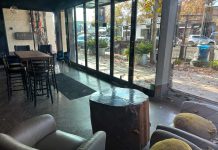Many of the landmark buildings of the region are graced with
decorative details that make them fascinating not just for their
historic significance but for architectural highlights as well. The
mission church of San Juan Bautista especially is filled with many
remarkable details that add to a visit.
SAN JUAN BAUTISTA – Many of the landmark buildings of the region are graced with decorative details that make them fascinating not just for their historic significance but for architectural highlights as well. The mission church of San Juan Bautista especially is filled with many remarkable details that add to a visit.
At the old mission church in San Juan Bautista, a small portion of the outside wall along the arched walkway allows visitors to see the dried adobe bricks used in the construction of the building. These adobe bricks were made from the mud clay found in the region mixed with straw and dried in the sun.
In the church itself, visitors can see footprints of a mountain lion imprinted into several of the floor tiles. Legend has it that while the tiles were on the ground drying, a mountain lion came through and stepped on them, leaving marks of its stroll for future generations of mission visitors to find.
One of the highlights of decorative touches in the church can be seen next to the main altar. On the wall here are six statues of saints, angels and Jesus. These were completed by Thomas Doak, an American sailor who jumped ship in Monterey and lived at the mission for a year, carving the statues. He painted these “reredos” in exchange for food and shelter.
Sunrise on the winter solstice, the first day of winter that takes place on Dec. 22 this year, is a special moment at the mission. The original designers of the mission aligned the front church window so that the rising sun sends a beam of light through it to hit the altar directly. This is the only day of the year when this happens.
Visitors at the mission church who are fans of Alfred Hitchcock movies should peer through the bars of the wooden door leading to stairs climbing to the bell tower. Hitchcock used these stairs for the climax of his 1958 classic movie “Vertigo.” He filmed James Stewart climbing up a portion of these steps as he chased Kim Novak up the bell tower.
Later, in Los Angeles, he had a reconstruction of the bell tower made with several more flights to give the impression the tower was much higher than the two-stories that it actually is.
Another architectural detail of Mission San Juan Bautista is the “cat door” carved into the blue side door in the Guadalupe Chapel. In the days of the padres, mice and rats getting into the grain storage was a serious problem. This little portal allowed cats access at all times to catch the rodents.
The mission gardens are well worth spending a leisurely visit, especially in the spring time when the roses and other flowers are in full bloom. The garden also has numerous species of cacti. During the days of the mission, the gardens were the center of activity for the Indians. Here they learned skills of carpentry, tanning, weaving, and candle-making necessary to construct the church as well as provide the necessities of daily life. Indians also were taught music and the Spanish language in this beautiful setting.
The mission gift shop was originally used as a storeroom. In 1847, it was a temporary home for the Breen family who survived the Donner party’s treacherous crossing of the Sierra Nevadas that harsh winter. Many Breen family descendants still live in the county and their family Bible is in the mission museum.
The cemetery on the north side of the church holds remains from more than 4,000 Christianized Native Americans as well as European settlers and priests. Ascencion Solorsano, the last pure blooded Native American of this mission, is buried in the cemetery. Her grave is marked by a red cross and a marker has been placed on the wall above her grave in her memory.
A recent addition to the church is an 8-foot-tall statue of St. John the Baptist, the mission patron. This work of art was a gift of parishioners Roger and Wendy Mairose and it was dedicated in December 2000. It bears the characteristics of the Mutsen band of Ohlone Indians who lived in the area when the Spanish padres arrived. With an ecstatic facial expression, St. John the Baptist’s outstretched arms worship an unseen Holy Spirit. The base of the statue shows the Native American equivalent of the symbols of the four Gospel evangelists. The model for the statue’s body was Michael Warren. The face was composed from those of two great-grandsons of Ascencion Solorsano.













